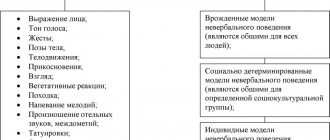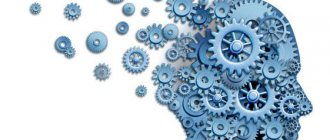Sensory memory: general characteristics and experimental research.
Sensory memory = sensory register was studied by Sperling. Experimentally
The main function of sensory memory is to ensure stability of perception, for example. In the visual modality, sensory memory ensures the continuity of the visual system between two sequences. In the auditory modality, sensory memory provides speech perception and understanding. If we did not have a sensory register, the world would be a sequence of disconnected images and disconnected sounds. Naiser of sensory memory in the visual modality gave the term iconic memory. And in the auditory - echoic.
Sperling's experiment
Sperling suggested that a person is able to remember more information in a short time than he can later reproduce.
Theoretical background:
1. experiments of the very famous neurophysiologist Hebb, who suggested that physiologically the mechanism of formation of a memory trace includes an activation phase of approximately 0.5 seconds. This phase is necessary to trigger changes in the nerve cells of the brain. Therefore, there must be a subsystem where information is stored until the brain stores it.
2. Donald Broadbunt's information processing model. According to this model, incoming information passes through 2 blocks (s_p); the first block processes information sequentially, the second can process only one block. To test his hypothesis, Sperling worked on a method called the post-stimulus instruction method. The experiment consisted of two series: the first used the full report method. On average, the subject was able to reproduce 4-5 letters out of 9.
Second series. The partial report method or the post-stimulus instruction method was used. In the second series, the subject reproduced 9 out of 12 stimuli.
An additional experiment was conducted to study storage time. The signal for playback could be given immediately after presentation of the matrix or with a time delay. As a result, it turned out that the maximum duration of information storage in visual memory is from 300 to 1000 ms.
Conclusion: i.e. There is sensory memory, the storage capacity of which is large and the duration is very short.
Echoic memory experiment
Scientist of the seas. He used the binaural presentation technique. Each message consisted of 4 isolated letters. The subject was required to give a partial report of the message depending on which light bulb was lit after presentation.
Result: information storage time in the auditory modality is 3 seconds. The fact that auditory information is stored in the sensory register longer than visual information is called the modality effect. The modality effect is related to the position effect. The recency effect is stronger in the positional curve for auditory stimuli than in the positional curve for visual stimuli.
Touch register:
1. ultra-short-term storage of information of a very large volume
2. sensory memory acts as a connection between the past and the present. The main function is to ensure continuity of operation of sensor systems.
3. sensory memory serves to control the adequacy and transformation of information carried out at higher levels.
4. sensory memory information is modality specific. The sensory register works automatically regardless of our will.
5. forgetting in the sensory register is associated with interference, new information arrives and erases the old. The second reason is decay over time.
6. After sensory memory, information is transferred to deeper memory subsystems. Information in sensory memory is not recognized.
In activity theory, the sensory memory block corresponds to the concept of sensory tissue.
Articles that we reviewed at the seminar on this topic (shortened a little).
P. Lindsay D. Norman MEMORY SYSTEMS
"Direct imprint" of sensory information
. This system maintains a fairly accurate and complete picture of the world, perceived by the senses. The duration of saving a picture is very short, about 0.1-0.5 s.
Tap your hand with four fingers. Watch the immediate sensations as they fade, so that at first you still have the real sensation of the tapping, and then you are left only with the memory that it happened.
Close your eyes, then open them for a moment and close them again. Watch how the clear, clear picture you see persists for a while and then slowly disappears.
Listen for any sounds, such as tapping your fingers or whistling. Observe how the clarity of the sound image disappears from consciousness.
Move a pencil (or just your finger) back and forth in front of your eyes, looking straight ahead. Notice the blurry image following the moving object.
This last illustration is the most important, since it can be used to determine approximately how long the image of an object is retained... the visual trace lasts about 0.25 s (250 ms) ...
Several types of memory are involved in the process of processing and interpreting information received from sensory systems. Each of them has a special function, stores a special form of information, has its own capacity limits, and they all operate on the basis of several different principles. Let's look at how each of these types of memory functions.
"Direct imprint" of sensory information
In order to identify the characteristic features of a sensory signal and establish what it is, it may take more time than the duration of the signal itself. Logical function of the “immediate imprint” system of sensory information (sometimes called iconic memory
— IP) is to provide feature extraction and pattern recognition systems with the time necessary to process signals affecting the senses.
After exposure to a visual signal, its image remains for several tenths of a second. This image is a “direct imprint” of visual sensory information. Therefore, it is possible to process a signal for a time longer than the duration of the signal itself. "Direct imprint" is useful in cases where the signal lasts only a short time, such as when watching movies and television programs; it also ensures continuity of perception when blinking or moving the eyes. When a signal is presented briefly, the duration of exposure plays almost no role; The only significant thing is the time during which the signal remains in the IP system.
Apparently, the IP system not only retains a clear picture of the sensory signals received during the last few tenths of a second, but also contains more information than can be used. This discrepancy between the amount of information stored in the sensory system and the amount that can be used at subsequent stages of analysis is extremely important. It indicates a certain limitation of memory capacity at subsequent stages, which is not characteristic of the sensory stage itself. This limitation manifests itself when trying to remember the presented material. The enormous amount of information contained in a sensory image is usually unimportant for interpreting its meaning. Moreover, often an excessive amount of detail only complicates the matter. Computers that try to read printed text, decipher phonograms of oral speech, and even read printed musical notations easily get confused if the input information contains the most simple details that a person would not pay any attention to when performing the same task. The smallest spots of paint or breaks in printed letters confuse computing devices, but people often simply do not notice even spelling errors.
The sensory system must maintain an accurate image of everything that affects the senses, because although much of this information will be unnecessary, the sensory system will not be able to determine which aspects of the input information may be relevant. This can only be done by systems that recognize and interpret signals. The IP system, it would seem, ideally suits its purpose. This system holds all the material for a short time, allowing pattern recognition processes to extract and select...
System capacity
IP. It is easy to show that the IP system initially contains more information than is used at subsequent stages of analysis. Suppose that the subject is momentarily presented with a complex visual image. He will be able to extract only a small amount of information contained in this image and will declare that he did not have enough time to “see” everything. But if the subject is told to look only at a certain part of the image, he will be able to focus all his attention on it and give a very accurate description. This suggests that a limitation in our ability to perceive sensory signals emerges during the process of analysis.
Sperling's experiment (by the way, this is the 9th specific question)
. This experiment should be carefully analyzed to become familiar with the basic methodology used in studying the "immediate imprint" of sensory information. In one of the main experiments, a card containing 9 letters arranged in three lines of 3 letters each (Fig. 1) was presented in a tachistoscope for 50 milliseconds. Usually the subject manages to read only 4 or 5 letters out of 9. Even if the number of letters in the card is increased or the duration of its presentation is changed, the subject almost invariably names approximately 4-5 letters (Fig. 2).
If we want to find out what a subject can actually see, we should not ask him to report everything he sees. It is possible that he sees all the letters and then forgets some of them. To test this assumption, we can ask him to give a partial account
about the letters presented. In this case, as before, we will present a card with nine letters, but then we will present a card where the place of one of them is marked with a rectangular icon, and we will ask the subject to simply name the marked letter. Before presenting a card with a rectangular mark, the subject does not know which of the nine letters will be marked (Fig. 1)2.
If the subject can always name a randomly marked letter, this means that he is actually able to see all nine letters in an instant; If he can find out which letter will be marked only after presenting the stimulus card, then he is holding all nine letters in the PI system in order to be able to find the marked letter there and name it.
The results of this experiment are shown in Fig. 3; The subject almost always correctly names the marked letter. Thus, he sees more than he can report. Apparently, in the original experiment, the IP system contained all the letters, but by the time the subject reproduced three or four of them, the rest had been erased from his memory.
This is a very valuable technique for studying perception. The next way to use it is to introduce a delay, that is, the mark does not appear immediately after the letters, but at a certain interval. This should help us figure out what the IP system is...
Typical results of such an experiment are shown in Fig. 4. The ability to reproduce an arbitrarily specified letter gradually decreases as the appearance of the cue is delayed, and after an interval of about 500 ms the curve levels off. Apparently, the "immediate imprint" is an image of the signal that is erased over time, so that after 0.5 s little of this image remains. (In other words, erasing an image in memory occurs exponentially with a time constant of approximately 150 ms.)
...The presentation of a second signal (masking) stops the processing of the first. Thus, although IP persists for some time after the presentation of a signal, the time for processing this signal can be strictly regulated by presenting a masking signal at the right moment.
One method for determining the rate at which processing of each presented letter can occur is to present masking signals following the presentation of the letters. The number of letters that the subject can list during processing time equal to the interval between the signal and the masking stimulus shows the speed of the system.
Currently, when tachistoscopic presentation of material to the subject is usually followed by a masking signal. Without disguise, the PI retains the image, so it is impossible to determine exactly how much time the subject spends processing the material. The use of masking allows the experimenter to accurately determine this time.
R. Atkinson. HUMAN MEMORY: MEMORY SYSTEM AND CONTROL PROCESSES
Control processes in the touch register
Because large amounts of information are entered into the sensory register and then quickly erased, the primary function of control processes at this level must be to select specific pieces of this information for transfer to short-term storage. The first decision an individual must make concerns which sensory register to focus attention on. Thus, in experiments with signals simultaneously arriving through several sensory channels, the subject can easily reproduce information obtained from a given sensory modality if he has been appropriately instructed in advance, but the accuracy of reproduction is significantly reduced if instructions are given after the presentation of the stimuli. Another process of attention is associated with this process - the transfer to the CWH of a selected part of a large amount of information received in one or another sensory modality. In this case, an example would be the scanning process in a visual registration system. Tachistoscopically presented letters can be scanned at a rate of approximately one letter per 10 m sec, with the scanning method depending on the subject. Sperling obtained the following result. When the signal indicating which row of the letter matrix should be reproduced was delayed for some time after the presentation of the stimulus, subjects developed two observation strategies. One of them was to obey the experimenter's instructions - to pay equal attention to all rows; The result of this strategy was a uniform distribution of errors and very low efficiency at long delays. Another strategy was to anticipate the row to be tested and focus only on it; in this case, the error variance increases, but the results with large delays are better than with the first strategy. The subjects were aware of the use of these strategies and reported it to the experimenter. One experienced subject, for example, reported switching from the first strategy to the second in an effort to improve performance when the interval between presentation and recall exceeded 0.15 sec. On the graph of the probability of a correct answer as a function of the delay time for this subject, with a general decrease with increasing delay, there was a downward jump at a delay of 0.15 seconds, indicating that the subject did not change the strategy quickly enough to achieve the optimal result.
Decisions regarding which sensory register to focus on and where and what to scan in a given system do not exhaust the types of choices that have to be made at this level. The individual has a number of strategies at his disposal for matching information in the register with information in long-term storage and thereby identifying the input signal. For example, in Estes and Taylor's experiment, the subject had to decide whether F or B was presented in a letter matrix. Using one strategy, the subject scans the letters in order, saying the “name” of each letter and checking visually whether it is B or F. If scanning ends before all the letters are presented, and neither B nor F is found, it can be assumed that the subject will try to guess the answer according to some personal preference. With another strategy, the subject could compare the features of each letter first with B and then with F, moving on to the next letter as soon as the difference is established; With this strategy, there is no need to scan all the features of each letter (that is, it is not necessary to generate a “name” for each letter). A third strategy could be to compare only one of the key letters while guessing the other, if a match has not been established by the time the scan is completed.
Anna's story
My daughter Masha, of all the games that children play, fell in love with “planks”. The essence of the game is quite simple: various objects, such as a fleecy rag, silk fabric, or plastic, are glued onto small wooden boards. The task is to determine by touch what kind of object is glued to the board. Masha has achieved great success in this game. She correctly identified almost all objects by touch, except those that had not been used before.
I knew that “planks” is a game that perfectly develops tactile memory. Therefore, I tried to play with my daughter more often. I tried to use as many different surfaces as possible. I especially remember a board with the fur of a cat glued to it, which was molting at the time. For a long time Masha could not determine what was glued to the board, but in the end she still gave the correct answer.
I believe that every parent should play games like this with their child. This is much better than if the child watched cartoons all day. It is known that a child’s speech is directly related to tactile memory.
By the way, I forgot to say the main thing - Masha graduated from school with honors and now dreams of becoming a presenter on television. She has all the makings for this. I think if it weren’t for the educational games that Masha played in her childhood, she would not have been able to deliver her own speech so well.
Forms of manifestations
Working memory, or working memory, includes 3 components: the phonological loop, the visuospatial sketchpad, and the central executive organ. The model was developed by psychologist A. Baddeley in 2000.
RAM components:
| Phonological cycle | Phonological storage (loop) | Responsible for auditory manipulation based on information. | An example is the continuous repetition, out loud or in the mind, of a group of numbers, letters or words to train the mind to remember them. This feature is a must when studying. The simplest example is a telephone number, people often repeat it over and over again to remember it, and it is stored in long-term memory |
| Articulation - rehearsal process | Responsible for rehearsal information residing in the phonological store | ||
| Visuospatial notebook | Saves 2- and 3-dimensional images of objects | A visual-spatial sketchbook helps you remember the location of objects. An example would be remembering a seat at a table if a person walks in a dark room. Memory recreates the visual image of the house, saves the layout of objects so that a person does not collide with them. | |
| Central executive power | Responsible for monitoring and coordinating the spatial sketchpad and phonological loop. Manipulates information and directs attention. | Helps with mental calculations and problem solving. Decides which of the other parts of working memory should process certain information as it arrives. | |
When all these components work together, a person functions normally: solves math problems, reads books, understands conversations with other people. At the beginning of the 21st century, A. Baddeley introduced a new component into the model of RAM, called the “episodic buffer”. It has been viewed as a temporary storage system that modulates and integrates various sensory information.
Definition
Working memory in psychology is a term that is defined as the limited capacity for temporary storage and processing of information for tasks such as comprehension, learning and reasoning.
Since the concept of working memory was introduced more than 50 years ago, various schools of thought have proposed all sorts of definitions of working memory based on the different cognitive domains it covers.
A common definition by many psychologists supports the idea that this type of memory is actively involved in goal-directed behavior in which information must be stored and processed to ensure successful completion of a task.
Before the advent of other competing models, the concept of working memory was described by the multicomponent working memory model proposed by A. Baddeley and G. Hitch in 1974, although the term "working memory" was first coined by Miller in 1960.
A. Baddeley compared RAM to a notepad in which important pieces of information are recorded, which are then deleted (or, more likely, replaced with more relevant information).
George Miller (1956), an American psychologist, in his study of memory capacity, found that most people can store about 7 items in working memory. Some people remember 5, others 9, so he called the power of this type of memory ± 2. Short-term memory is stored for about 20 seconds. The working memory model was proposed by Graham Hitch and Alan Baddeley in 1974.
Canadian psychologist Endel Tulving demonstrated that although information can be stored for a long time, there is no guarantee that it will be retrieved exactly when needed.
How to improve
Cognitive science is still a new and evolving field, and its developments are constantly being tested. There are many theories and hypotheses regarding how to increase working memory capacity, but it will be some time before science can come to a consensus on what will truly improve a person's abilities.
What you should do to make the most of your working memory:
- Avoid music and distracting sounds during mental work and study.
- Highlight the most important information by saying it out loud.
- Use visual mnemonics to keep track of more ideas at once.
- Visualization can improve learning compared to simple generalization in some subjects. Try to use your imagination more while studying.
- When solving a problem, you must first break it down into simpler parts.
If a person wants to increase his intelligence, he can use methods for improving working memory offered by psychologists.
Creativity
A study conducted by Andreas Fink, a scientist from Germany, found that when study participants thought of creative ways to use everyday objects and products, areas of the brain associated with working memory were activated.
Therefore, when you see everyday items, you should try to find non-standard uses for them. For example, use an ice cube tray or a plastic egg carton as a place to store decorations.
Meditation
Mindfulness exercises such as meditation have been shown to improve attention and concentration and increase working memory capacity. A study published by American scientists in the journal Psychological Science showed that students' working memory improved after taking an intensive two-week meditation course.
The measure used to determine the increase in working memory capacity was a reading comprehension test.
Brain testing
Working memory in psychology is the type of memory that is important for reasoning, learning, and understanding. Currently, on websites you can find many exercises and games aimed at developing these abilities. Most of them are free, so trying them out is easy. Smart games are fitness for the brain.
Outdoor workouts
Several studies show that running stimulates the prefrontal cortex, known as the seat of working memory. Barefoot running is more recommended as research conducted by Tracey Alloway, Ph.D., and Ross Alloway, Ph.D., shows that barefoot runners exhibit better working memory than those who ran in shoes.
Again, this is just one study, and it has not yet proven a cause-and-effect relationship, but it can improve health.
Working memory is vital for most activities, especially when it comes to learning. In addition, it is important for focusing on a specific activity and eliminating distractions. In many works on psychology, scientists have proven that you can increase your intelligence by improving your working memory.







